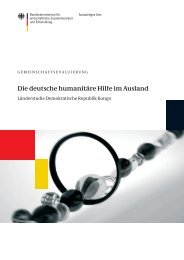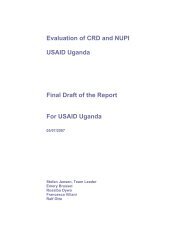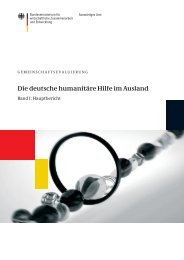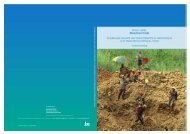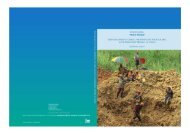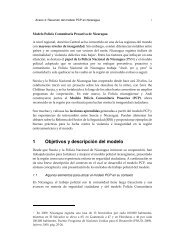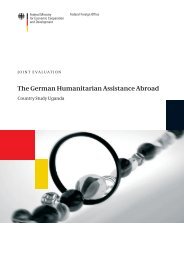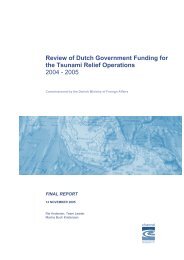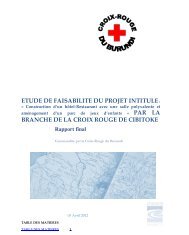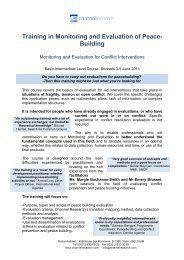A ripple in development? - Channel Research
A ripple in development? - Channel Research
A ripple in development? - Channel Research
Create successful ePaper yourself
Turn your PDF publications into a flip-book with our unique Google optimized e-Paper software.
were distributed over time. Who received aid first <strong>in</strong> the immediate<br />
aftermath of the tsunami based on government security regulations at<br />
the time? Who received aid later? Who received more aid? Who received<br />
less aid?<br />
Household livelihood histories were collected from all the different<br />
members of a household who happened to be present at the time the<br />
<strong>in</strong>terviews were conducted (380 persons <strong>in</strong>terviewed as mentioned <strong>in</strong><br />
the <strong>in</strong>troduction), thereby enabl<strong>in</strong>g greater triangulation and crosscheck<strong>in</strong>g<br />
of facts and chronologies. The stories they tell recount their<br />
lives from before the tsunami and up to the present moment of the<br />
evaluation. One of the key questions asked was whether <strong>in</strong>dividuals <strong>in</strong><br />
a household had <strong>in</strong>herited a specific livelihood skill from with<strong>in</strong> the family.<br />
To illustrate, a household may consist of fishermen who learned<br />
their specific skills from their fathers and grandfathers. If their livelihoods<br />
were completely destroyed because of the tsunami, the evaluation<br />
team would try to understand how the fishermen adapted given the<br />
<strong>in</strong>stitutional arrangements at the time. Did they try to build new skills as<br />
construction workers for reconstruction projects? Or did they resort to<br />
be<strong>in</strong>g unskilled day labourers look<strong>in</strong>g for paid work where ever available?<br />
When did they resume fish<strong>in</strong>g as their ma<strong>in</strong> livelihood activity (if at<br />
all?)? As households were asked to tell their stories about changes over<br />
time, the evaluation team tried to understand adaptations and adjustments<br />
that they made and how external aid played a role.<br />
If livelihood security was achieved at the later po<strong>in</strong>t <strong>in</strong> time of the<br />
evaluation, household histories would reflect a predictable and stable<br />
pattern of <strong>in</strong>come generat<strong>in</strong>g activities to meet consumption needs. As<br />
most of the affected households <strong>in</strong> all three contexts were located <strong>in</strong> the<br />
agricultural and fish<strong>in</strong>g sectors and subsistence economies, this pattern<br />
of <strong>in</strong>come generation and consumption should be relatively predictable<br />
for each year. However this annual pattern and the volume of activity<br />
may be expected to vary depend<strong>in</strong>g upon any fluctuations <strong>in</strong> market<br />
demand, sudden price hikes such as those witnessed <strong>in</strong> the rise <strong>in</strong> food<br />
prices <strong>in</strong> late 2008 etc 41 .<br />
As a consequence there is a deficit of resources where consumption<br />
exceeds <strong>in</strong>come; household welfare is then reduced <strong>in</strong> the given time<br />
period. The solution to address this deficit is for the household to seek<br />
out alternative <strong>in</strong>come generat<strong>in</strong>g activities, where <strong>in</strong>come can then<br />
match consumption e.g. a fisherman can complement or substitute his<br />
41<br />
To illustrate, there are fixed seasonal periods for harvest<strong>in</strong>g and fish<strong>in</strong>g <strong>in</strong> a year. Farmers and fishermen<br />
will carry out most of their activities with<strong>in</strong> this period, br<strong>in</strong>g their produce to market to sell<br />
and then spread out their <strong>in</strong>come for use dur<strong>in</strong>g the rest of the year. Consumption patterns will<br />
then match with <strong>in</strong>come generat<strong>in</strong>g patterns. This pattern of behaviour can be thought of <strong>in</strong> economic<br />
term<strong>in</strong>ology as ‘consumption smooth<strong>in</strong>g’. If there fails to be a match with<strong>in</strong> a given time<br />
period as determ<strong>in</strong>ed by the household e.g. a calendar year, a harvest<strong>in</strong>g cycle etc., this is<br />
because of the occurrence of an exogenous shock such as a natural disaster, a s<strong>in</strong>gle event or<br />
repeated events of conflict.<br />
52



